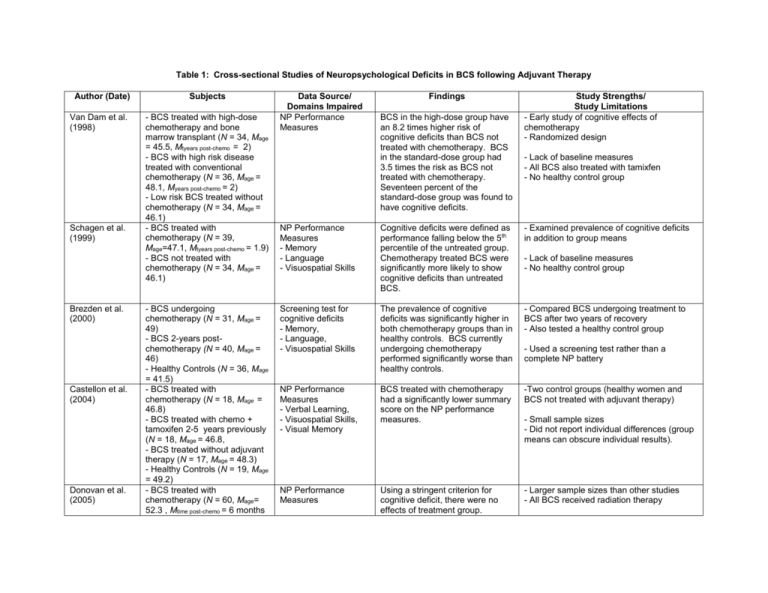Table 1: Cross-sectional Studies of Neuropsychological Deficits in
advertisement

Table 1: Cross-sectional Studies of Neuropsychological Deficits in BCS following Adjuvant Therapy Author (Date) Van Dam et al. (1998) Schagen et al. (1999) Brezden et al. (2000) Castellon et al. (2004) Donovan et al. (2005) Subjects - BCS treated with high-dose chemotherapy and bone marrow transplant (N = 34, Mage = 45.5, Mtyears post-chemo = 2) - BCS with high risk disease treated with conventional chemotherapy (N = 36, Mage = 48.1, Myears post-chemo = 2) - Low risk BCS treated without chemotherapy (N = 34, Mage = 46.1) - BCS treated with chemotherapy (N = 39, Mage=47.1, Mtyears post-chemo = 1.9) - BCS not treated with chemotherapy (N = 34, Mage = 46.1) - BCS undergoing chemotherapy (N = 31, Mage = 49) - BCS 2-years postchemotherapy (N = 40, Mage = 46) - Healthy Controls (N = 36, Mage = 41.5) - BCS treated with chemotherapy (N = 18, Mage = 46.8) - BCS treated with chemo + tamoxifen 2-5 years previously (N = 18, Mage = 46.8, - BCS treated without adjuvant therapy (N = 17, Mage = 48.3) - Healthy Controls (N = 19, Mage = 49.2) - BCS treated with chemotherapy (N = 60, Mage= 52.3 , Mtime post-chemo = 6 months Data Source/ Domains Impaired NP Performance Measures Findings BCS in the high-dose group have an 8.2 times higher risk of cognitive deficits than BCS not treated with chemotherapy. BCS in the standard-dose group had 3.5 times the risk as BCS not treated with chemotherapy. Seventeen percent of the standard-dose group was found to have cognitive deficits. Study Strengths/ Study Limitations - Early study of cognitive effects of chemotherapy - Randomized design - Lack of baseline measures - All BCS also treated with tamixfen - No healthy control group NP Performance Measures - Memory - Language - Visuospatial Skills Cognitive deficits were defined as performance falling below the 5th percentile of the untreated group. Chemotherapy treated BCS were significantly more likely to show cognitive deficits than untreated BCS. - Examined prevalence of cognitive deficits in addition to group means Screening test for cognitive deficits - Memory, - Language, - Visuospatial Skills The prevalence of cognitive deficits was significantly higher in both chemotherapy groups than in healthy controls. BCS currently undergoing chemotherapy performed significantly worse than healthy controls. - Compared BCS undergoing treatment to BCS after two years of recovery - Also tested a healthy control group NP Performance Measures - Verbal Learning, - Visuospatial Skills, - Visual Memory BCS treated with chemotherapy had a significantly lower summary score on the NP performance measures. -Two control groups (healthy women and BCS not treated with adjuvant therapy) NP Performance Measures Using a stringent criterion for cognitive deficit, there were no effects of treatment group. - Larger sample sizes than other studies - All BCS received radiation therapy - Lack of baseline measures - No healthy control group - Used a screening test rather than a complete NP battery - Small sample sizes - Did not report individual differences (group means can obscure individual results). Adams-Price et al. (2009) Yamada et al. (2010) - BCS not treated with chemotherapy (N = 83, Mage = 57.6) - BCS treated with chemotherapy (N = 38, Mage = 55.3, Mtime post-treatment = 19.1 months) - Healthy Controls (N = 55, Mage = 55.3) - Lack of baseline measures - Did not report individual differences - Useful Field of View Test (measures 3 components of attention) - Processing Speed - BCS treated with NP Performance chemotherapy (N = 60, Mage = Measures 72.8, Mtime post-chemotherapy = 16.8 - Executive Function years) - Working Memory - Healthy Controls matched to - Attention each BCS from an existing database (N = 30) Koppelmans et - BCS treated with NP Performance chemotherapy (N = 196, Mage = Measures al. (2012) 64.1, Mtime post-treatment = 21.2 - Memory (immediate years) and delayed) - Healthy controls from an -Executive Function existing database (N = 1509, - Processing Speed Mage = 57.9) - Psychomotor Speed Note. M = mean; BCS = breast cancer survivor; NP = neuropsychological There was a significant interaction between age and treatment group such that older BCS performed significantly worse on the processing speed component of the task BCS scored significantly worse than healthy controls in several domains after an extended interval post-chemotherapy. BCS had significantly lower NP summary scores than healthy controls, scoring the same or worse than controls on all measures. -Examined interaction of age and treatment - The BCS sample included a small number of older participants - Healthy Controls performed at ceiling for the processing speed measure. An effect of age may have been masked. -Long interval post-chemotherapy. -Lack of untreated BCS control group -Global NP performance measures were not reported. -Long interval post-chemotherapy -Large sample size Lack of untreated BCS control group




